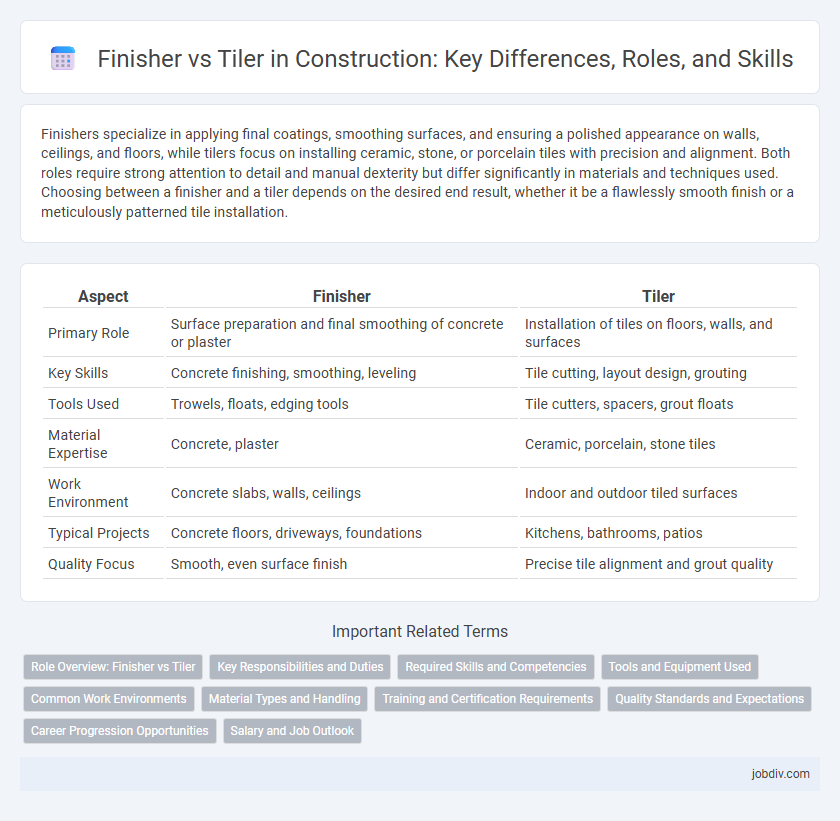Finishers specialize in applying final coatings, smoothing surfaces, and ensuring a polished appearance on walls, ceilings, and floors, while tilers focus on installing ceramic, stone, or porcelain tiles with precision and alignment. Both roles require strong attention to detail and manual dexterity but differ significantly in materials and techniques used. Choosing between a finisher and a tiler depends on the desired end result, whether it be a flawlessly smooth finish or a meticulously patterned tile installation.
Table of Comparison
| Aspect | Finisher | Tiler |
|---|---|---|
| Primary Role | Surface preparation and final smoothing of concrete or plaster | Installation of tiles on floors, walls, and surfaces |
| Key Skills | Concrete finishing, smoothing, leveling | Tile cutting, layout design, grouting |
| Tools Used | Trowels, floats, edging tools | Tile cutters, spacers, grout floats |
| Material Expertise | Concrete, plaster | Ceramic, porcelain, stone tiles |
| Work Environment | Concrete slabs, walls, ceilings | Indoor and outdoor tiled surfaces |
| Typical Projects | Concrete floors, driveways, foundations | Kitchens, bathrooms, patios |
| Quality Focus | Smooth, even surface finish | Precise tile alignment and grout quality |
Role Overview: Finisher vs Tiler
Finishers specialize in smoothing and polishing concrete surfaces to achieve a durable, visually appealing finish, ensuring proper curing and surface integrity. Tilers are responsible for accurately cutting and laying tile materials such as ceramic, porcelain, or stone onto floors and walls, focusing on alignment, spacing, and grout application. Both roles require precision and expertise, but finishers primarily work with concrete textures while tilers specialize in decorative and functional tile installations.
Key Responsibilities and Duties
Finishers focus on smoothing and leveling concrete surfaces to ensure a polished, durable finish, utilizing tools such as trowels and floats. Tilers specialize in measuring, cutting, and installing various types of tiles on floors, walls, and ceilings, ensuring precise alignment and grout application. Both roles require attention to detail, but finishers primarily work with concrete while tilers handle ceramic, porcelain, and stone materials.
Required Skills and Competencies
Finishers require strong attention to detail, expertise in surface preparation, and proficiency in applying plaster, drywall, or concrete finishes to achieve smooth, durable surfaces. Tilers need precision in measuring and cutting tiles, knowledge of various adhesive materials, and the ability to create intricate patterns while ensuring proper alignment and spacing. Both roles demand manual dexterity, physical stamina, and an understanding of safety protocols on construction sites.
Tools and Equipment Used
Finishers primarily use trowels, floats, and screeds to smooth and level concrete surfaces, ensuring a polished and durable finish. Tilers rely on tile cutters, spacers, grout floats, and wet saws to accurately cut, set, and grout tiles for precise alignment and aesthetic appeal. Both trades require specialized hand tools and power tools tailored to their distinct materials and processes.
Common Work Environments
Finishers and tilers both work predominantly in construction sites and residential buildings, often collaborating on interior finishing projects. Finishers specialize in smoothing and preparing surfaces such as concrete floors and walls, while tilers focus on installing ceramic, porcelain, or stone tiles in bathrooms, kitchens, and flooring areas. Both trades require working in variable environments, including new builds, renovations, and outdoor patios, frequently exposing workers to dust, moisture, and physical labor conditions.
Material Types and Handling
Finishers specialize in applying surface materials such as plaster, stucco, and drywall compound, requiring precision in smoothing and texturing surfaces for durability and aesthetic appeal. Tilers focus on installing ceramic, porcelain, and natural stone tiles, emphasizing careful alignment and grout application to ensure water resistance and longevity. Both professionals handle materials with care to prevent damage, but finishers often work with wet, malleable compounds while tilers manage rigid, heavy tiles requiring precise cutting and fitting.
Training and Certification Requirements
Finishers require specialized training in concrete finishing techniques and must often complete apprenticeships to gain hands-on experience, while certification varies by region and may include concrete finishing certifications. Tilers undergo vocational training focused on tile installation, surface preparation, and waterproofing, with certifications such as the Certified Tile Installer (CTI) offered by trade organizations to validate skills and ensure compliance with industry standards. Both roles necessitate safety training and adherence to local building codes, emphasizing the importance of continuous education to stay updated with evolving construction technologies.
Quality Standards and Expectations
Finishers and tilers both play crucial roles in construction, with quality standards centered on surface smoothness, alignment, and durability. Finishers are expected to deliver flawlessly smooth surfaces like plaster or concrete while ensuring seamless transitions, whereas tilers must achieve precise tile placement with consistent grout lines and level surfaces. The highest quality expectations require strict adherence to manufacturer specifications and industry standards such as ASTM and ANSI for tiling and finishing materials.
Career Progression Opportunities
Finishers often advance by specializing in high-end surface treatments or moving into supervisory roles managing multiple projects, increasing their responsibility and earning potential. Tilers can progress by mastering complex tile patterns, working with luxury materials, or transitioning into design consulting and site management positions that influence project aesthetics and workflow. Both career paths offer opportunities for certification and skill diversification, enhancing marketability and opening doors to higher-level construction and renovation roles.
Salary and Job Outlook
Finishers typically earn an average salary ranging from $35,000 to $50,000 annually, while tilers can expect salaries between $40,000 and $55,000, reflecting their specialized skill in precision work. The job outlook for both positions remains positive, with tilers projected to experience a 5% growth over the next decade due to increased demand for decorative and durable flooring. Finishers also benefit from steady employment opportunities driven by ongoing construction and renovation projects targeting surface completion.
Finisher vs Tiler Infographic

 jobdiv.com
jobdiv.com